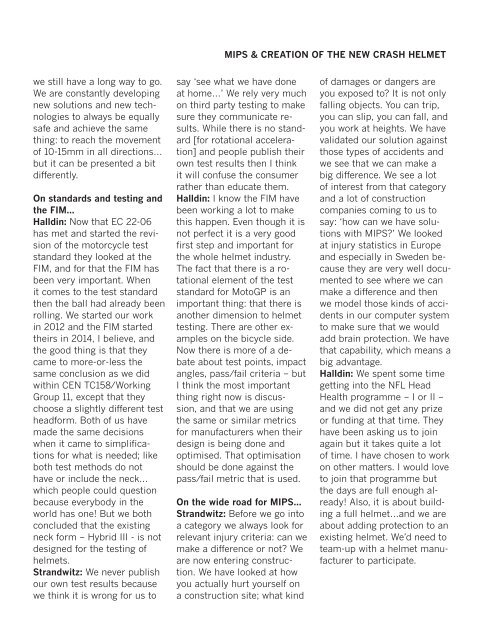Create successful ePaper yourself
Turn your PDF publications into a flip-book with our unique Google optimized e-Paper software.
MIPS & CREATION OF THE NEW CRASH HELMET<br />
we still have a long way to go.<br />
We are constantly developing<br />
new solutions and new technologies<br />
to always be equally<br />
safe and achieve the same<br />
thing: to reach the movement<br />
of 10-15mm in all directions…<br />
but it can be presented a bit<br />
differently.<br />
<strong>On</strong> standards and testing and<br />
the FIM…<br />
Halldin: <strong>No</strong>w that EC 22-06<br />
has met and started the revision<br />
of the motorcycle test<br />
standard they looked at the<br />
FIM, and for that the FIM has<br />
been very important. When<br />
it comes to the test standard<br />
then the ball had already been<br />
rolling. We started our work<br />
in 2012 and the FIM started<br />
theirs in 2014, I believe, and<br />
the good thing is that they<br />
came to more-or-less the<br />
same conclusion as we did<br />
within CEN TC158/Working<br />
Group 11, except that they<br />
choose a slightly different test<br />
headform. Both of us have<br />
made the same decisions<br />
when it came to simplifications<br />
for what is needed; like<br />
both test methods do not<br />
have or include the neck…<br />
which people could question<br />
because everybody in the<br />
world has one! But we both<br />
concluded that the existing<br />
neck form – Hybrid III - is not<br />
designed for the testing of<br />
helmets.<br />
Strandwitz: We never publish<br />
our own test results because<br />
we think it is wrong for us to<br />
say ‘see what we have done<br />
at home…’ We rely very much<br />
on third party testing to make<br />
sure they communicate results.<br />
While there is no standard<br />
[for rotational acceleration]<br />
and people publish their<br />
own test results then I think<br />
it will confuse the consumer<br />
rather than educate them.<br />
Halldin: I know the FIM have<br />
been working a lot to make<br />
this happen. Even though it is<br />
not perfect it is a very good<br />
first step and important for<br />
the whole helmet industry.<br />
The fact that there is a rotational<br />
element of the test<br />
standard for MotoGP is an<br />
important thing: that there is<br />
another dimension to helmet<br />
testing. There are other examples<br />
on the bicycle side.<br />
<strong>No</strong>w there is more of a debate<br />
about test points, impact<br />
angles, pass/fail criteria – but<br />
I think the most important<br />
thing right now is discussion,<br />
and that we are using<br />
the same or similar metrics<br />
for manufacturers when their<br />
design is being done and<br />
optimised. That optimisation<br />
should be done against the<br />
pass/fail metric that is used.<br />
<strong>On</strong> the wide road for MIPS…<br />
Strandwitz: Before we go into<br />
a category we always look for<br />
relevant injury criteria: can we<br />
make a difference or not? We<br />
are now entering construction.<br />
We have looked at how<br />
you actually hurt yourself on<br />
a construction site; what kind<br />
of damages or dangers are<br />
you exposed to? It is not only<br />
falling objects. You can trip,<br />
you can slip, you can fall, and<br />
you work at heights. We have<br />
validated our solution against<br />
those types of accidents and<br />
we see that we can make a<br />
big difference. We see a lot<br />
of interest from that category<br />
and a lot of construction<br />
companies coming to us to<br />
say: ‘how can we have solutions<br />
with MIPS?’ We looked<br />
at injury statistics in Europe<br />
and especially in Sweden because<br />
they are very well documented<br />
to see where we can<br />
make a difference and then<br />
we model those kinds of accidents<br />
in our computer system<br />
to make sure that we would<br />
add brain protection. We have<br />
that capability, which means a<br />
big advantage.<br />
Halldin: We spent some time<br />
getting into the NFL Head<br />
Health programme – I or II –<br />
and we did not get any prize<br />
or funding at that time. They<br />
have been asking us to join<br />
again but it takes quite a lot<br />
of time. I have chosen to work<br />
on other matters. I would love<br />
to join that programme but<br />
the days are full enough already!<br />
Also, it is about building<br />
a full helmet…and we are<br />
about adding protection to an<br />
existing helmet. We’d need to<br />
team-up with a helmet manufacturer<br />
to participate.

















